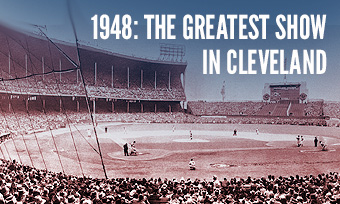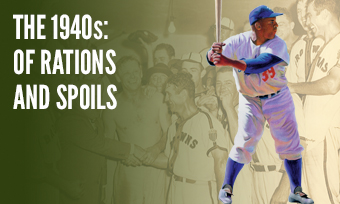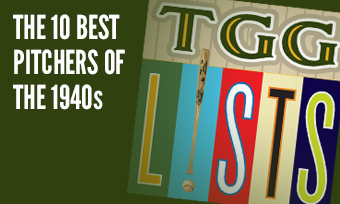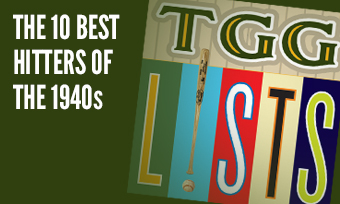The Yearly Reader
Leaders and Honors, 1948
Our list of baseball’s top 10 hitters and pitchers in both the American League and National League for the 1948 baseball season, as well as the awards and honors given to the game’s top achievers of the year.
The National League’s Top 10 Hitters, 1948
Bold type in brick red indicates league leader.
1. Stan Musial, St. Louis
Key Numbers: .376 average, 135 runs, 230 hits, 46 doubles, 18 triples, 39 home runs, 131 RBIs, 79 walks, .450 on-base percentage, .702 slugging percentage.
Musial’s greatest year at the plate included a sudden jump in homers to a career-high 39, four five-hit games (tying Ty Cobb’s season record), a career-best batting average and a slugging percentage that was the NL’s highest between 1930 and 1994. He was one homer away from grabbing a share of the NL lead with Johnny Mize and Ralph Kiner—and earning a triple crown in the process.
2. Johnny Mize, New York
Key Numbers: .289 average, 110 runs, 26 doubles, 40 home runs, 125 RBIs, 94 walks.
Mize was first cousin of Babe Ruth’s second wife—but his power (90 homers from 1947-48) suggested he should have been more a part of the Babe’s direct lineage. His home run on the last day of the season tied him with Kiner for the NL lead—for the second straight year.
3. Ralph Kiner, Pittsburgh
Key Numbers: 156 games, .265 average, 104 runs, 40 home runs, 123 RBIs, 112 walks.
The young Pirates slugger easily could have won the NL home run crown outright, but only went deep once over his last 23 games.
4. Bob Elliott, Boston
Key Numbers: .283 average, 99 runs, 24 doubles, 5 triples, 23 home runs, 100 RBIs, 131 walks.
Elliott’s 131 walks stick out like a sore thumb on his career stat sheet; it was his only time drawing at least 100.
5. Sid Gordon, New York
Key Numbers: .299 average, 100 runs, 26 doubles, 30 home runs, 107 RBIs, 74 walks.
Muscular, Brooklyn-born Sid Gordon was no enemy in a Giants uniform, as the Dodgers even gave him a special day.
6. Enos Slaughter, St. Louis
Key Numbers: .321 average, 91 runs, 176 hits, 27 doubles, 11 triples, 11 home runs, 90 RBIs, 81 walks.
Slaughter failed to total exactly 100 runs for the fourth straight year, but that didn’t make the aggressive veteran any less dangerous.
7. Jackie Robinson, Brooklyn
Key Numbers: .296 average, 108 runs, 170 hits, 38 doubles, 8 triples, 12 home runs, 85 RBIs, 7 hit-by-pitches, 22 stolen bases.
In his second season with the Dodgers, Robinson settled in and hit for the only cycle of his career. And no, not all the pitchers that hit him a collective NL-high seven times were born in the South.
8. Andy Pafko, Chicago
Key Numbers: .312 average, 82 runs, 171 hits, 30 doubles, 26 home runs, 101 RBIs.
In the second of 16 straight years with a winning record at Wrigley Field, the Cubs found a strong offensive presence in Pafko, making up for the decline of earlier Cubs stars of the decade (Bill Nicholson, Phil Cavarretta).
9. Jeff Heath, Boston
Key Numbers: 115 games, .319 average, 26 doubles, 5 triples, 20 home runs, 76 RBIs.
One of the reasons Bob Elliott (above) drew so many walks was that opposing pitchers felt they could have an easier time than Heath, who frequently batted behind him; boy, we’re they wrong.
10. Del Ennis, Philadelphia
Key Numbers: .290 average, 86 runs, 171 hits, 40 doubles, 30 home runs, 95 RBIs.
The young outfielder found his career jet stream, hitting more home runs than his first two seasons combined.
The American League’s Top 10 Hitters, 1948
1. Ted Williams, Boston
Key Numbers: .369 average, 124 runs, 188 hits, 44 doubles, 25 home runs, 127 RBIs, 126 walks, .497 on-base percentage, .615 slugging percentage.
Williams’ great start had him at .400 by mid-season—even after being sidetracked at camp with appendicitis. He also set a major league record with 21 straight games reaching base safely at least twice.
2. Joe DiMaggio, New York
Key Numbers: .320 average, 110 runs, 190 hits, 26 doubles, 11 triples, 39 home runs, 155 RBIs, 67 walks, 8 hit-by-pitches.
Before age and injuries began to overcome him, Joe DiMaggio produced his last pure majestic set of numbers.
3. Lou Boudreau, Cleveland
Key Numbers: .355 average, 116 runs, 199 hits, 34 doubles, 6 triples, 18 home runs, 106 RBIs, 98 walks.
All of Bill Veeck’s tricks and gimmicks would have been for naught had he traded away Boudreau before 1948—which he nearly did.
4. Tommy Henrich, New York
Key Numbers: .308 average, 138 runs, 181 hits, 42 doubles, 14 triples, 25 home runs, 100 RBIs, 76 walks.
It seemed as if the majority of numbers put up by clutch-time hero Tommy Henrich came when they were needed the most. It’s also impressive to note, given the big-time numbers put up above by Williams and DiMaggio, that he led the AL in extra-base hits.
5. Joe Gordon, Cleveland
Key Numbers: .280 average, 96 runs, 32 home runs, 124 RBIs, 77 walks.
The veteran second baseman’s career renaissance peaked with career highs in both home runs and RBIs.
6. Ken Keltner, Cleveland
Key Numbers: .297 average, 91 runs, 166 hits, 31 home runs, 119 RBIs, 89 walks.
Practically riding the same career track as Gordon, Keltner awoke from a prolonged career funk and was every bit the equal on the power stats.
7. Vern Stephens, Boston
Key Numbers: 155 games, .269 average, 114 runs, 171 hits, 25 doubles, 8 triples, 29 home runs, 137 RBIs, 77 walks, 25 grounded into double plays.
After struggling to build up great numbers with a Browns lineup that gave him no protection, Stephens was sent to Fenway and was given the dream job of hitting behind Ted Williams. He responded with his first of three seasons averaging 147 RBIs per year.
8. Dom DiMaggio, Boston
Key Numbers: 155 games, .285 average, 648 at-bats, 127 runs, 185 hits, 40 doubles, 9 home runs, 87 RBIs, 101 walks, 10 stolen bases.
A great year for the DiMaggio family; besides Joe’s vintage effort above, younger brother Dom hit prewar stride and then some.
9. Bobby Doerr, Boston
Key Numbers: .285 average, 94 runs, 23 doubles, 6 triples, 27 home runs, 111 RBIs, 83 walks.
Like Vern Stephens above, Doerr relished in hitting behind both Ted Williams and Stephens, and thus became the third member of the Red Sox’ 100-RBI club (a common occurrence in the years after World War II).
10. Pat Mullin, Detroit
Key Numbers: .288 average, 91 runs, 16 doubles, 11 triples, 23 home runs, 80 RBIs, 77 walks.
A future top scout and coach for Detroit, Mullin made the most of his one full-time year—leading the Tigers in most offensive categories.
The National League’s Top 10 Pitchers, 1948
1. Harry Brecheen, St. Louis
Key Numbers: 2.24 ERA, 20 wins, 7 losses, 7 shutouts, .741 win percentage, 233.1 innings, 49 walks, 149 strikeouts.
The Mean Brecheen returned after a decent 1947 campaign—but even despite this effort and Stan Musial’s enormous set of numbers, the Cardinals couldn’t make it to first place.
2. Johnny Schmitz, Chicago
Key Numbers: 2.64 ERA, 18 wins, 13 losses, 242 innings.
After losing a NL-high 18 games in 1947, Schmitz won 18 for a last-place Cub team while batters hit a league-low .215 against him.
3. Johnny Sain, Boston
Key Numbers: 2.60 ERA, 24 wins, 15 losses, 42 appearances, 39 starts, 28 complete games, 314.2 innings.
Sain gave everything he had, notching the most innings and wins of any single-season NL pitcher during the 1940s.
4. Rex Barney, Brooklyn
Key Numbers: 3.10 ERA, 15 wins, 13 losses, 44 appearances, 34 starts, 246.2 innings, 122 walks, 6 hit-by-pitches.
Barney had his one year in the sun, racking up 15 of his 35 career wins, one of which was the only no-hitter ever thrown by a Dodger at the Polo Grounds, home of the archrival Giants. Wildness would eventually get the better of him.
5. Dutch Leonard, Philadelphia
Key Numbers: 2.51 ERA, 12 wins, 17 losses, 225.2 innings, 54 walks.
Despite a better ERA than the previous year, Leonard’s record was reversed for the worse—from 17-12 to 12-17. As expected, poor run support was the culprit.
6. Preacher Roe, Brooklyn
Key Numbers: 2.63 ERA, 12 wins, 8 losses, 34 appearances, 22 starts, 177.2 innings, 33 walks.
Struggling at Pittsburgh for two years—the result of a skull fracture suffered fighting a referee while coaching a prep basketball team—Roe came to Brooklyn and, as he would admit years later, revived his career with the occasional spitball.
7. Johnny Vander Meer, Cincinnati
Key Numbers: 3.41 ERA, 17 wins, 14 losses, 33 starts, 232 innings, 124 walks.
With Ewell Blackwell slipping into temporary decline, Vander Meer channeled his earlier self and briefly bumped himself up to vintage form.
8. Larry Jansen, New York
Key Numbers: 3.61 ERA, 18 wins, 12 losses, 42 appearances, 36 starts, 277 innings, 54 walks.
In his second year at the major league level, Jansen figured out how to pitch at the oblong Polo Grounds, posting a far better ERA (2.76) than on the road (4.57).
9. Warren Spahn, Boston
Key Numbers: 3.71 ERA, 15 wins, 12 losses, 35 starts, 257 innings.
What would be considered a fine year for most pitchers was a relative downer for Spahn—who produced his highest season ERA until 1964, the year he finally began to fall apart at age 43.
10. Sheldon Jones, New York
Key Numbers: 3.35 ERA, 16 wins, 8 losses, .667 win percentage, 5 saves, 55 appearances, 21 starts, 201.1 innings, 17 intentional walks, 10 wild pitches, 6 hit-by-pitches.
Despite a certain lack of control, Jones was relied upon by the Giants to the point that he was pegged with the nickname “Available.”
The American League’s Top 10 Pitchers, 1948
1. Gene Bearden, Cleveland
Key Numbers: 2.43 ERA, 20 wins, 7 losses, .741 win percentage, 37 appearances, 29 starts, 6 shutouts, 229.2 innings, 106 walks, 42 grounded into double plays.
The one-year wonder was Cleveland’s biggest stars-and-planets-aligning story in a year where everything went right for the Indians; the knuckleballer went 25-31 over six other major league seasons.
2. Bob Lemon, Cleveland
Key Numbers: 2.82 ERA, 20 wins, 14 losses, 43 appearances, 37 starts, 20 complete games, 10 shutouts, 293.2 innings, 129 walks.
Two years earlier, Lemon was a struggling center fielder for the Indians; now he was the AL’s best pitcher. Highlights from his 1948 résumé: Authoring the two longest consecutive scoreless-inning streaks of his career (31 and 29), and his only no-hitter.
3. Hal Newhouser, Detroit
Key Numbers: 3.01 ERA, 21 wins, 12 losses, 39 appearances, 35 starts, 272.1 innings.
A year after getting shafted by poor-hitting teammates, Newhouser was allowed to return to perceptive form with his fourth (and last) 20-win campaign.
4. Bob Feller, Cleveland
Key Numbers: 3.56 ERA, 19 wins, 15 losses, 44 appearances, 38 starts, 280.1 innings, 116 walks, 164 strikeouts.
Feller’s 164 strikeouts weren’t even half of the 348 he registered in 1946, but it was good enough to lead the AL for his last time.
5. Ray Scarborough, Washington
Key Numbers: 2.82 ERA, 15 wins, 8 losses, 31 appearances, 26 starts, 185.1 innings.
For a year at least, the right-hander was head-and-shoulders above the rest of the Senators’ staff; without him, DC pitchers were 41-89 with a 4.95 ERA.
6. Mel Parnell, Boston
Key Numbers: 3.14 ERA, 15 wins, 8 losses, 35 appearances, 27 starts, 212 innings, 10 intentional walks.
The 26-year-old lefty grew well into the role as future Red Sox ace in his first full season, winning 12 of his games after the All-Star break.
7. Vic Raschi, New York
Key Numbers: 3.84 ERA, 19 wins, 8 losses, .704 win percentage, 36 appearances, 31 starts, 222.2 innings.
In his first full season, Raschi ran out of gas down the stretch and was demoted to the bullpen for the final two weeks—costing him a chance at 20 wins. He’d make up for it in each of the next three years.
8. Joe Dobson, Boston
Key Numbers: 3.56 ERA, 16 wins, 10 losses, 38 appearances, 32 starts, 245.1 innings.
Parnell’s late-season rise contrasted with Dobson’s erosion during the same time, but the overall effort was still met with thumbs-ups from Red Sox teammates.
9. Dizzy Trout, Detroit
Key Numbers: 3.43 ERA, 10 wins, 14 losses, 32 appearances, 23 starts, 183.2 innings.
For the second straight year, Trout pitched well enough to win 20 games—but only got halfway there.
10. Spec Shea, New York
Key Numbers: 3.41 ERA, 9 wins, 10 losses, 28 appearances, 22 starts, 8 complete games, 155.2 innings, 89 walks, .208 batting average against.
An honorable sophomore campaign for the 1948 rookie standout; injuries and poor performances would sidetrack his career until he refreshed with Washington in 1952.









